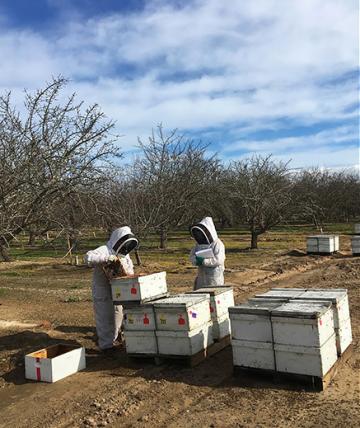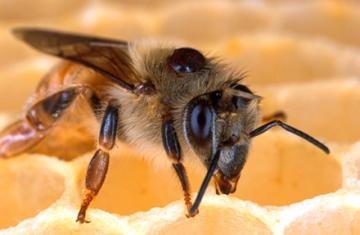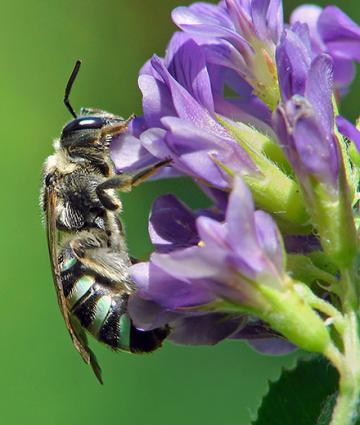Bolstering Bees in a Changing Climate
In observance of National Pollinator Month, Tellus presents a special article authored by two of ARS’s leading bee researchers.
Honey bees and other pollinators are critically important to securing the nation’s food supply and providing ecosystem services that insure plant diversity, soil stability, and species richness. Fruit and seed yields increase when many bee species are present, whether in undisturbed ecosystems or in crops such as apples or almonds, where pollination by both honey bees and native bees generates greater yields and higher quality fruit. There are more than 4,000 species of bees in the United States, with many bumble bee and solitary bee species remaining to be described and life histories understood.
While the importance of pollinators is widely known, populations have been declining for more than a decade. Losses of managed honey bee colonies are nearly 40 percent annually, jeopardizing the financial solvency of our nation’s beekeeping industry. Causes for the colony losses include nutritional stress from lack of pollen and nectar sources, parasitic Varroa mites and the viruses they transmit, and pesticide exposure. Many of the same stresses are also affecting other bee species such as bumblebees, where many species are experiencing decreasing colony numbers, and one is now on the endangered species list. Similar declines in populations of solitary bees might also be occurring, but survey data are lacking.

Scientists work with honey bee colonies that were shipped from cold-storage facilities in Idaho to almond orchards in California as part of a cold-storage overwintering management study at the ARS Carl Hayden Bee Research Center in Tucson, AZ. (Emily Watkins De Jong, D4350-1)
Climate change is a significant factor contributing to the decline in pollinator populations. The warming of the planet and changes in weather patterns are altering the synchrony between flowering plants and their pollinators, causing nutritional stress. Radical shifts in temperature, droughts, and floods are disrupting native ranges for pollinators, making ecosystems unsuitable for the processes needed to sustain populations, such as overwinter hibernation, spring nest establishment, and reproduction. In the case of honey bees, the warmer temperatures in late fall and winter that are occurring with greater frequency in northern latitudes have made it increasingly difficult to reduce winter colony losses. This is because the warmer fall and winter temperatures are extending the period when bees are foraging. This disrupts the colony age structure and resource utilization, enabling Varroa mites to migrate among colonies on foragers, spreading this parasite and the viruses it transmits throughout apiaries.
Research conducted by Agricultural Research Service (ARS) scientists is focused on understanding the impact of a changing climate on bee health and survival and finding solutions to reduce pollinator losses. In the spirit of delivering cutting-edge scientific tools and innovative solutions, scientists at the ARS Carl Hayden Bee Research Center in Tucson, AZ, are developing management schemes for overwintering honey bee hives in cold-storage facilities to reduce the impact of Varroa mites and nutritional stress and increase colony survival. Scientists there also are studying how environmental factors affect the nutrients in pollen and nectar and how growing conditions can be managed to optimize the nutritional quality of these food sources.

European honey bee with a Varroa mite on its back. The mites cause death and disease in bee colonies. (Scott Bauer, K9544-1)
In Logan, UT, the ARS Pollinating Insect-Biology, Management, Systematics Research Unit is the home of the U.S. National Pollinating Insect Collection. Scientists there are investigating other bee species that can be managed for pollination and learning how multiple species are needed for pollination of our crops and natural ecosystems. For bumblebees and managed solitary bee species, research is defining how climate is affecting bee nutrition, development, reproduction, and survival. The research will increase our understanding of how variable climate impacts different bee species and direct the next steps for beekeepers and managers to help their bees survive these challenges.
The overall goal of this research is to sustain our nation’s agroecosystems and natural resources and to ensure the economic competitiveness and excellence of our agriculture.—By Diana Cox-Foster and Gloria DeGrandi-Hoffman, ARS.
Diana Cox-Foster is the research leader of the ARS Pollinating Insect-Biology, Management, Systematics Research Unit in Logan, UT. Gloria DeGrandi-Hoffman is the research leader at the ARS Carl Hayden Bee Research Center in Tucson, AZ.
You May Also Like


